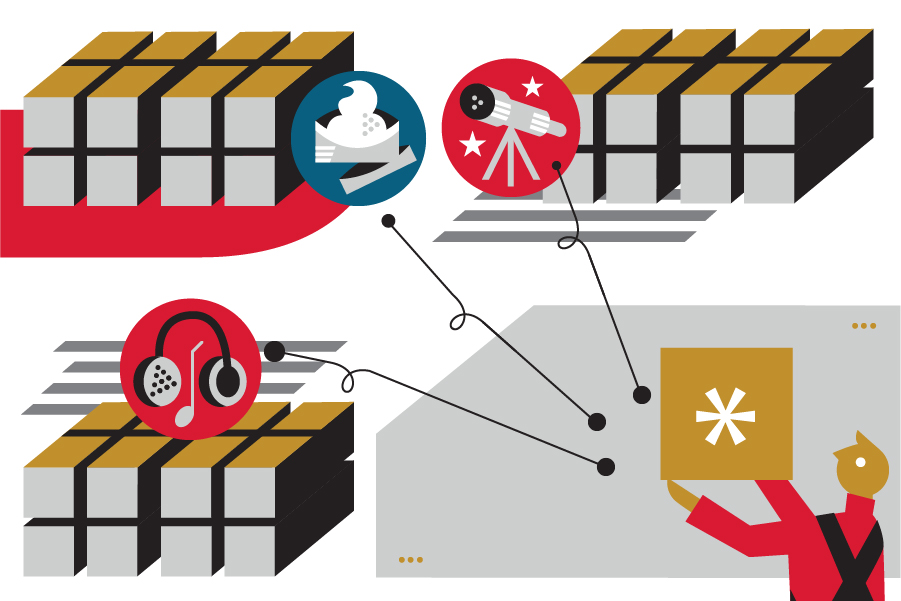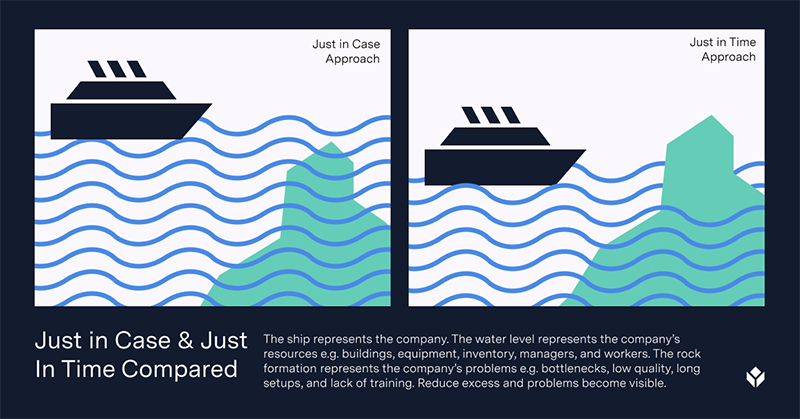Logistics
Industries
Technology & Innovations
E-commerce
E-commerce Fulfillment Services
Lease & Maintenance
Semi Trucks
Logistics
E-commerce
Lease & Maintenance
Buy Used Trucks

Just in Time (JIT) logistics has been the standard approach to managing inventory and supplier relationships for decades. It’s what allows retailers to order extra stock at a moment’s notice, or to accept backorders with confidence that they can be fulfilled within fast timeframes.
But the COVID-19 pandemic has put Just in Time logistics, with its intentionally lean and globally distributed supply chains, under unprecedented strain. When it’s no longer possible for businesses to trust suppliers or shippers’ ability to meet tight deadlines, it’s clear that the JIT model alone is no longer fit for purpose.
The question is: What’s going to replace Just in Time logistics?
Nearly eighteen months on from the pandemic, we’ve seen a noticeable pivot back towards an older, more conservative approach to inventory management.
JIC is a logistics strategy where businesses choose to keep a large surplus of finished inventory and raw materials on hand to avoid selling out or facing unexpected supply chain issues. It’s a conservative approach to inventory management where the costs of storing excess stock are considered preferable to the risk of losing sales due to lean inventory levels.
JIC is often referred to as the traditional approach in inventory management, originating from time periods where there wasn’t such ready access to markets due to slower transportation and manufacturing methods. This made it necessary for businesses to stockpile inventory due to a lack of certainty over when new shipments would be ready.
By contrast, Just in Time (JIT) logistics operates on the basis that raw materials, inventory, and spare parts will be available at a moment’s notice. This strategy emerged out of post-war economies where businesses gained the ability to manage inventory at the granular level. Instead of having to prepare for the worst-case scenario i.e. running out of stock or late shipments, the globalized nature of supply chains has made it possible to receive supplies exactly as they’re needed - and no sooner.
In sum, the JIT model prioritizes the reduction of holding costs and inefficiencies that lead to excess inventory, such as poor demand forecasting and a lack of supply chain visibility, where JIC sees increased storage costs as worth the price for greater certainty.

Tulip’s ship and iceberg analogy.
Data analysis platform Tulip uses a brilliant analogy to highlight the differences between JIT and JIC. A ship approaching an iceberg has two options: They can either try moving out the way as quickly as possible or ensure that there’s enough water for them to pass over the top without incident.
The former represents the JIT model, which is a cheaper, low-maintenance option when the proverbial seas are calm and businesses have the ability to forecast demand accurately e.g. to spot icebergs from a long way off.
But when the seas get stormy and rough, even the best forecasting cannot prevent businesses from hitting icebergs - and possibly sinking.
In times of uncertainty, the businesses who come out in the best shape are those who ensure that their water level is high i.e. maintaining high surplus inventory.
In sum, Just in Time logistics is by far the more profitable and flexible strategy - but only when times are good. When supply chains are under unprecedented strain JIT strategies are prone to breaking down, as we saw during the COVID-19 pandemic.
More resilient to supply shocks. The JIC model gives businesses much more wiggle room in the case of supply chain disruption because it doesn’t rely on small, regular supplies of inventory. Businesses have a lot more certainty over their ability to whether external events because they have the extra resources to avoid costly exercises, like pausing new orders or lengthening delivery timeframes.
BUT: A lot of capital is tied up in stock. JIC leaves businesses with a lot less liquid capital due to more expenditure on stock, which could create financial issues if inventory isn’t moving effectively. This also creates a lot less flexibility for businesses to capitalize on further growth opportunities.
Less precise forecasting is needed. Having large amounts of inventory on hand at all times means that businesses don’t need to rely on extremely detailed demand forecasting. Rather than ordering the bare minimum required to meet demand and avoid storage costs, businesses using JIC have the additional advantage of being able to boost market share when competitors run out of stock.
BUT: High storage costs. Put simply, more inventory means that a business needs more space to store stock and maintain product integrity. This can increase your holding costs by as much as 20% to 30% of total inventory value, which may erode the financial benefits of avoiding lost sales.
Fewer lost sales opportunities. Because businesses using JIC logistics always retain a surplus of inventory, they’re much less likely to miss out on sales due to running out of popular SKUs. If demand is increasing, they can elect to increase production for a bigger replenishment later.
BUT: A high risk of dead stock. Dead stock is when businesses are saddled with excess inventory that they’re not able to sell, either because it’s out of season or has been replaced by a newer item. This is one of the biggest risks of JIC, as larger inventory volumes mean that your business will need to use strong promotional tools to move stock effectively and prevent losing revenue.
More responsive to marketplace trends. Flexible supply chains mean that merchants using JIT strategies can monitor trends in their industry and respond quickly to short-term surges in interest for certain products, giving them a competitive edge over other retailers who can’t pivot as effectively.
BUT: Strong demand forecasting is needed. To offset the risk of carrying less inventory, businesses need to conduct extremely detailed forecasts to predict the likely popularity of different items. But even with the best data analysis, it isn’t possible to identify every possible factor that could influence demand, which leaves you open to losing sales.
Reduced storage costs. Businesses using JIT have a lot less inventory on hand at any given time, which means they’re spending a lot on less storing stock that isn’t on the shelf or picking area. In addition to lowering storage costs, this also cuts the associated labor and transportation costs associated with warehousing.
BUT: Difficulty weathering supply shocks. Businesses using JIT logistics have very little room for error when it comes to coordinating supply chains. Even minor delays to the arrival of new inventory can cause big knock-on effects, such as selling out of stock or being unable to fulfill online orders in a timely manner. So, when a major event takes place that affects a certain supplier or transportation node, businesses have few levers to pull to alleviate the impact.
The vast majority of businesses have transitioned to JIT logistics models over the past few decades due to the relative ease of coordinating global supply chains and the lure of big cost savings. This left businesses completely unprepared for what happened in March 2020.
The COVID-19 pandemic has caused extreme disruption to supply chains and transportation networks after a long period of global stability. With the majority of businesses now relying on longer, more complex supply chains that span multiple countries, the impact of the pandemic was immediate.
As stay-at-home restrictions came into force around the country, consumers were faced with increased difficulty in getting the goods they needed. This led to panic buying and a massive increase in online shopping orders, both of which left merchants with extensive short shortages and difficulty getting goods to market due to overstretched suppliers and limited transportation networks.
Moreover, seismic shifts in consumer demand have made it immensely challenging to achieve accurate forecasting. With routines and pastimes upended by COVID-19 restrictions, experienced-based purchases such as travel and dining out were replaced by products that could be enjoyed from home. This has left brands frantically trying to keep up with the whims of a disrupted economy.
With the after-effects of the pandemic set to continue for several months to come, many businesses are transitioning to a JIC model of hoarding inventory to try and offset ongoing uncertainty - an inventory management strategy thought to be long dead in a globalized world. But is returning to Just in Case logistics the answer?
As we’ve already discussed, both JIT and JIC have their own pros and cons that businesses need to weigh up carefully when deciding how to approach inventory management. With the national squeeze on warehouse space bigger than ever, more storage space for surplus inventory isn’t necessarily there for the taking. But with trend-based product categories like fashion, accessories, and cosmetics now beginning to recover as stay-at-home orders come to an end, the flexibility to pivot with peaks and troughs in consumer demand is central to a smooth recovery. Being weighed down by inventory that’s suddenly lost its appeal can result in sluggish sales and difficulty capitalizing on changes in demand.
So, what is the solution for businesses that are struggling to reorganize supply chains?
There may be areas of your product catalog where taking a JIC approach is advantageous. If demand for a range of core SKUs is consistent, keeping excess inventory on hand will help you weather potential difficulties in supply. On the flip side, ordering extra seasonal inventory can put a lot of extra pressure on your business. It’s better to keep these selections deliberately lean to avoid being stuck with products that can very quickly lose their appeal.
Automation has become a crucial tool to plug gaps in labor and achieve supply chain visibility across warehouses and fulfillment facilities. This helps to streamline workflows and eliminate inefficiencies that can worsen supply chain fragility, including human error and manual transfers of data that slow down inventory processing.
Brands are used to scaling to manage short-term demand during peak season, but this has taken on a new level of complexity during the pandemic. With no blueprint to fall back on, merchants have struggled to manage high ongoing order volumes that are only going to increase as we get closer to the end of the year. Now is the time to prioritize scalability by partnering with a 3PL that can supply you with labor and storage space that can expand and retract during times of fluctuating consumer demand.